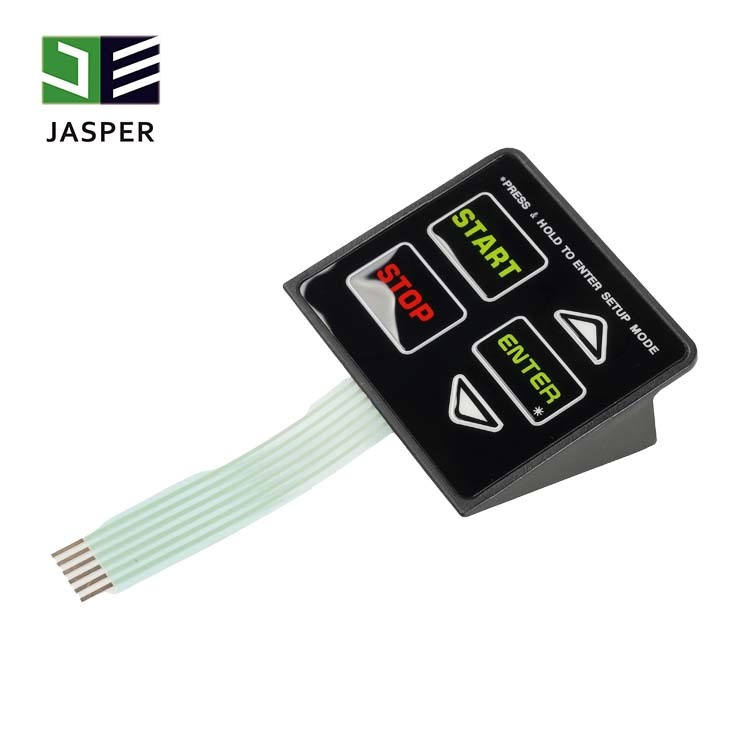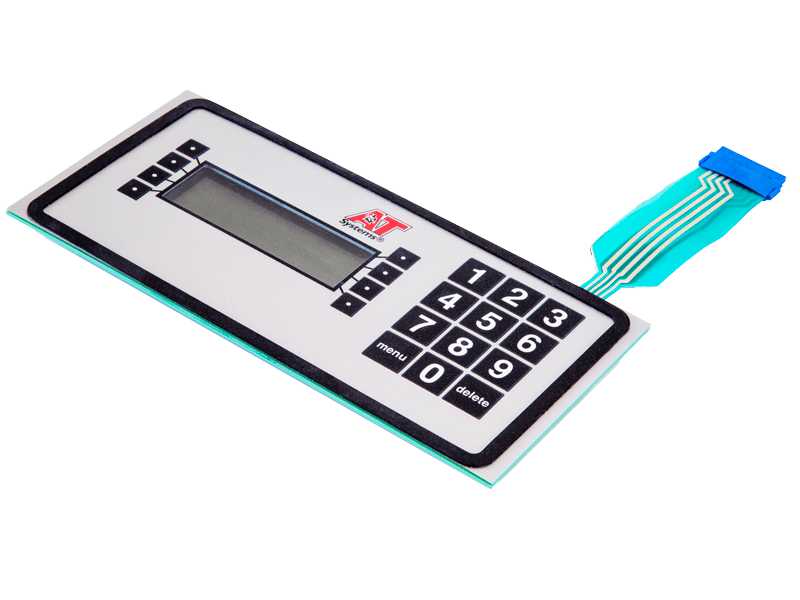Your Preferred Membrane Switch Manufacturer for Factory Applications
Your Preferred Membrane Switch Manufacturer for Factory Applications
Blog Article
Exploring the Manufacturing Process of Membrane Switch for Numerous Industries
The manufacturing procedure of Membrane switches is a complex venture that demands accuracy and interest to detail. From picking ideal materials to implementing rigorous quality assurance actions, each action plays a crucial role in ensuring functionality. Numerous sectors, consisting of vehicle and clinical, count on these components for their one-of-a-kind applications. Comprehending the ins and outs of this process reveals considerable understandings into how these buttons are produced and their influence across varied industries.
Comprehending Membrane Switches: An Introduction

Trick Materials Made Use Of in Membrane Switch Manufacturing
In Membrane switch production, the choice of vital materials substantially influences functionality and longevity. Conductive products, adhesives, and finishings play essential roles, while substratum selection influences overall performance and integrity. Comprehending these components is important for enhancing the design and production of Membrane buttons.
Conductive Materials Introduction
Conductive materials play an essential duty in the performance of Membrane buttons, ensuring trustworthy electrical connections within the device. Generally made use of materials consist of silver, copper, and carbon-based inks, each offering distinctive benefits. Silver is favored for its high conductivity and sturdiness, making it suitable for applications requiring robust efficiency. Copper, while slightly much less conductive than silver, is an affordable choice typically utilized in printed circuits. Carbon-based inks give a versatile option, appropriate for applications where versatility and reduced prices are focused on, although they have actually reduced conductivity compared to metal alternatives. The selection of conductive materials directly affects the general dependability, life expectancy, and efficiency of the Membrane button, making it an essential factor to consider in the production process.
Adhesives and Coatings
Finishes and adhesives are crucial parts in the manufacturing of Membrane buttons, supplying crucial bonding and safety homes. These materials guarantee that various layers of the button, consisting of visuals overlays and wiring, adhere securely to one another, enhancing resilience and functionality. Generally made use of adhesives consist of pressure-sensitive adhesives (PSAs) and epoxy-based formulas, which provide solid attachment and strength. Coatings, such as polyurethane or acrylic, serve to protect versus environmental elements, including dampness, abrasion, and chemicals. Furthermore, coverings can enhance responsive comments and visual charm, adding to the general customer experience. The selection of appropriate adhesives and finishings is important for enhancing efficiency and durability in varied applications throughout different sectors, making certain that Membrane switches fulfill particular functional demands.
Substrate Option Aspects
Substratum choice plays a vital duty in the manufacturing of Membrane switches, as it significantly influences their overall performance and longevity. Trick materials such as polyester, polycarbonate, and versatile printed motherboard (FPCBs) are typically made use of for their distinct buildings. Polyester is preferred for its cost-effectiveness and resistance to abrasion, making it suitable for applications with high wear. Polycarbonate offers premium clarity and influence resistance, ideal for atmospheres calling for high visibility. FPCBs provide improved adaptability and are frequently utilized in intricate designs. The option of substratum additionally impacts factors like thermal stability, chemical resistance, and simplicity of printing. Inevitably, selecting the proper substrate is vital for making certain the functionality and durability of Membrane switches across various markets.
The Design Refine of Membrane Switches
The style procedure of Membrane buttons is a vital phase that greatly influences the capability and aesthetic appeals of the final item - membrane switch manufacturer. It starts with defining the particular demands of the application, consisting of dimensions, switch design, and tactile feedback choices. Designers have to take into consideration customer interaction, guaranteeing that the switch is instinctive and accessible.Next, products are selected based upon longevity, adaptability, and ecological resistance. The integration of graphics and branding elements is likewise essential, as it boosts visual appeal and interaction. Prototyping enables for iterative testing, making it possible for changes based on individual feedback and efficiency Home Page evaluations.Additionally, the design has to make up the electric components, such as adapters and circuits, making certain dependability and convenience of use. Inevitably, an effective design balances performance, visual appeals, and customer experience, paving the method for reliable manufacturing and long-lasting performance in different markets
Printing Strategies for Membrane Switches
The printing methods utilized in Membrane switch production play an important duty in determining the final item's top quality and functionality. Screen printing offers benefits such as sturdiness and lively shade application, while electronic printing advancements provide versatility and precision in design. Understanding these methods can considerably impact the general performance of Membrane buttons in various applications.
Screen Printing Advantages
Countless advantages make display publishing a favored technique for producing Membrane switches. This approach allows for premium, lively colors and thorough styles, which are crucial for interface applications. Screen printing is especially reliable for using thick ink layers, improving durability and responsive responses. Additionally, it offers exceptional attachment to various substrates, guaranteeing durability in requiring environments. The process is affordable for big production runs, as it decreases arrangement time and waste. Display printing sustains a large array of inks, including specialized and UV-curable alternatives, allowing flexibility in layout. Its ability to generate constant outcomes throughout several units look at these guys makes it a reputable choice for manufacturers aiming for top quality and effectiveness in Membrane button manufacturing.
Digital Printing Innovations

Developments in electronic printing innovation are transforming the manufacturing of Membrane buttons, providing suppliers ingenious services that enhance style adaptability and performance. Digital printing permits complex designs and high-resolution graphics, making it possible for customized branding and functionality without the limitations of typical techniques. This technique decreases setup times and prices, assisting in much shorter production runs and very little waste, making it suitable for businesses with differing needs. Furthermore, improvements in ink formulations provide much better durability and bond, ensuring longevity in various settings. As sectors progressively look for personalized and complex layouts, digital printing attracts attention as a vital method, establishing a brand-new requirement in Membrane button manufacturing. The assimilation of these technologies placements suppliers to meet progressing market needs efficiently.
Assembly and Layering of Membrane Switch Elements
Mindful setting up and web layering of Membrane switch elements are essential to ensuring capability and resilience. This procedure begins with the accurate alignment of various layers, including the visuals overlay, sticky, circuit layer, and support product. Each element needs to be thoroughly positioned to maintain electrical honesty and customer interface responsiveness.During assembly, conductive traces are related to the circuit layer, commonly made from products like polyester or polycarbonate. This layer is important, as it beams when pressure is used. The glue utilized for bonding these layers is additionally selected for its capacity to endure environmental stresses while keeping a safe bond.Heat and stress are frequently used throughout the assembly process to ascertain that the layers stick appropriately without endangering the functionality of the button. Ultimately, attention is offered to the edge sealing to safeguard against moisture and impurities, safeguarding the durability of the Membrane switch in various industrial applications.
Quality Assurance Procedures in Membrane Switch Production
Quality control actions play an important function in making certain the reliability and efficiency of Membrane switches over following the assembly and layering of their components. In the manufacturing process, a number of key assessments are conducted to support top quality criteria. These include visual assessments for problems in printing and adhesive application, as well as useful examinations to confirm the responsiveness of each switch.Additionally, environmental screening is carried out to examine the buttons' toughness versus temperature fluctuations and humidity exposure. Manufacturers often apply statistical process control (copyright) techniques to keep track of manufacturing uniformity, allowing early detection of anomalies.Furthermore, traceability systems are developed to track parts and materials, guaranteeing accountability and promoting remembers if needed. Calibration of tools and adherence to industry standards are likewise important to maintaining product integrity. Jointly, these quality assurance procedures safeguard the efficiency of Membrane switches over throughout different applications, inevitably boosting consumer fulfillment.
Applications of Membrane Changes Across Different Industries
Membrane buttons are used throughout a diverse range of sectors, showcasing their convenience and adaptability. In the medical market, they provide water resistant and dependable interfaces for gadgets such as analysis equipment and infusion pumps, making sure hygiene and convenience of use. The automobile market utilizes Membrane buttons for control panel controls, enabling seamless interaction in between the vehicle driver and automobile systems.In customer electronic devices, these switches are discovered in home appliances and handheld devices, offering a sleek, modern aesthetic while boosting capability. Industrial applications also utilize Membrane switches over for machinery control panels, where sturdiness and resistance to extreme conditions are essential.Furthermore, the aerospace and protection markets utilize Membrane switches for cabin instrumentation and communication systems, prioritizing integrity and performance under extreme conditions. Generally, Membrane switches play an essential role in enhancing the customer experience and functional performance throughout numerous domain names.
Regularly Asked Inquiries
How Lengthy Does It Require To Make a Membrane Layer Switch?
The manufacturing time for a membrane button typically varies from a few days to a number of weeks - membrane switch manufacturer. Variables affecting this period include design complexity, material availability, and production quantity, all influencing the total timeline substantially
What Is the Common Lifespan of a Membrane Layer Switch?
The normal life-span of a membrane switch typically ranges from 1 to 5 million actuations, depending on elements such as worldly quality, ecological conditions, and usage regularity, considerably influencing resilience and general efficiency.
Can Membrane Switches Be Personalized for Specific Applications?
Membrane buttons can certainly be personalized for particular applications. Their design adaptability permits changes in size, form, colors, and graphics, guaranteeing compatibility with unique demands across numerous sectors and boosting performance and user experience.

Are Membrane Switches Eco-friendly?
The ecological effect of Membrane switches differs. Some materials utilized may not be eco-friendly, while developments in manufacturing processes are significantly concentrating on sustainability, intending to minimize waste and advertise recyclable elements in their manufacturing.
What Are the Typical Failing Settings of Membrane Switches?
Usual failure modes of Membrane buttons include delamination, sticky failure, damage from usage, wetness access, and electric failings. These problems can considerably affect capability, efficiency, and life-span in numerous applications throughout various sectors. Membrane buttons can be personalized to fit details style demands, such as form, functionality, and size, making them very adaptable.The building and construction commonly involves multiple layers, including a visuals overlay, adhesive, and a circuit layer, which work with each other to produce a seamless customer experience. In Membrane switch manufacturing, the choice of key materials significantly influences performance and resilience. The automotive sector employs Membrane buttons for dashboard controls, allowing seamless communication between the motorist and lorry systems.In customer electronics, these buttons are found in appliances and handheld gadgets, supplying a streamlined, modern-day aesthetic while boosting performance. Industrial applications additionally take advantage of Membrane switches over for machinery control panels, where sturdiness and resistance to severe conditions are essential.Furthermore, the aerospace and protection industries use Membrane switches for cockpit instrumentation and communication systems, prioritizing dependability and efficiency under extreme conditions. Membrane switches can certainly be tailored for details applications.
Report this page